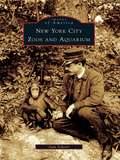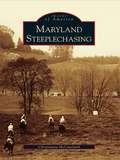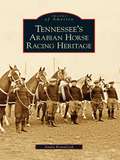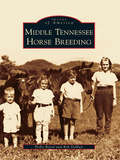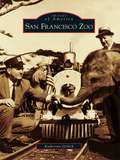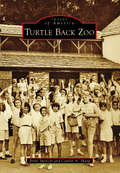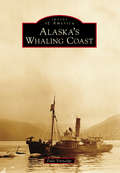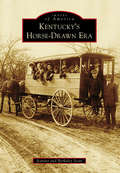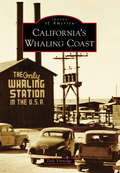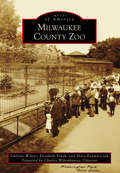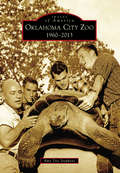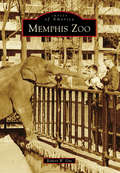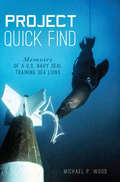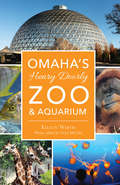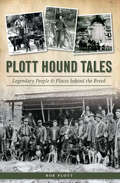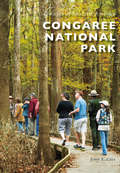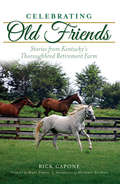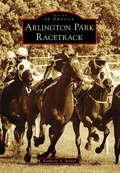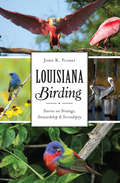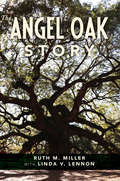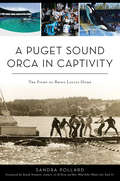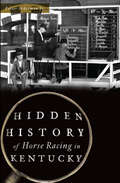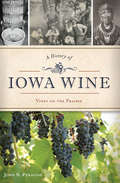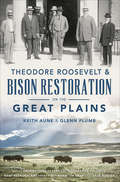- Table View
- List View
New York City Zoos and Aquarium (Images of America)
by Joan ScheierSituated within the five boroughs of New York City are five zoos and one aquarium. New York City Zoos and Aquarium chronicles the establishment of the Central Park Zoo, the Bronx Zoo, the Prospect Park Zoo, the Queens Zoo, the Staten Island Zoo, and the New York Aquarium. Popular children's zoos are also featured. The city's first zoo opened in Central Park in the 1850s, while the newest zoo opened in Queens after the 1964 World's Fair. While each one of these facilities has many similarities, they all have their own unique attributes. All of the facilities are focused on education, conservation, and the care of the animals that now reside in natural habitats.
Maryland Steeplechasing (Images of America)
by Christianna MccauslandEach spring, thousands of spectators clamber onto hillsides with picnics and binoculars to watch steeplechase racing, a fast-paced equine sport born out of the fundamentals of fox hunting. Since 1894, when the first Maryland Hunt Cup was run, the month of April has been synonymous with steeplechase racing. Starting with the Elkridge-Harford Hunt races and continuing with the National Steeplechase Association- sanctioned "Big Three" races--the My Lady's Manor, Grand National, and Maryland Hunt Cup--the countryside buzzes with horses and fans every Saturday throughout the month. Images of America: Maryland Steeplechasing traces the history of Maryland's other triple crown of racing, bringing together images of Maryland's three most-coveted races for the first time in one volume.
Tennessee's Arabian Horse Racing Heritage
by Andra KowalczykHistorically Tennessee's horse breeding industry has received recognition for producing prized Thoroughbred racehorses, smooth-gaited Tennessee Walking horses, and sturdy work mules. Historical accounts, however, largely overlook the contributions of Tennessee horse breeders to the sport of Arabian horse racing. One hundred years have passed since anti-gambling legislation ended Tennessee's reign over the "sport of kings," Thoroughbred horse racing. However, the state has figured prominently in the development of Arabian horse racing. Leading up to the inaugural race event in 1959, and in more recent years as the amateur recreation became a bona fide sport, Tennesseans have had a calculable effect on the creation and advancement of Arabian horse racing in the United States.
Middle Tennessee Horse Breeding
by Rob Dehart Perky BeiselBreeding fine horses has been both big business and pastime for Middle Tennesseans since settlers first entered the Cumberland Valley during the American Revolution. The fertile pastures and mild climate of the area lent itself to horse breeding, and the populace embraced the benefits. Horses functioned as the technology that plowed fields, moved goods and people, and serviced the military. Horse racetracks dotted the landscape, and a person's social status sometimes rested on the possession of fine horses and good horsemanship. This combination of culture and geography in Middle Tennessee gave rise to some of the most celebrated horse breeders in the nation.
San Francisco Zoo
by Katherine GirlichIn 1922, philanthropist and president of the San Francisco Parks Commission, Herbert Fleishhacker, purchased a 60-acre site in southwestern San Francisco. Fleishhacker Pool was built in 1925 and an adjoining zoo added in 1929. Originally called Fleishhacker Zoo, it featured a variety of exotic wildlife. Major exhibits were built in the 1930s Depression era as part of the Work Progress Administration (WPA). This book celebrates the San Francisco Zoo's 80-year history as it revisits cherished animals and structures like Monkey Island, Storyland, and Dentzel Carousel. The zoo holds a special place in the hearts of many, as it is a great San Francisco treasure along the foggy shores of Ocean Beach.
Turtle Back Zoo (Images of America)
by Brint Spencer Caitlin A. SharpWith 140 animals of 40 species, the Turtle Back Zoo opened in 1963 as a seasonal children's zoo. The community and county government brought the zoo to life, while the Essex County Park Commission administered its daily functions. With funds generated from the sale of land for highway development, architects and builders selected a fairy tale, Hans Christian Andersen aesthetic for their theme. Once opened, Turtle Back Zoo was an instant success, and its popularity led to it becoming a year-round attraction that appealed to all ages. The family recreation experience came to include wildlife conservation education as well. In the early 2000s, the zoo was renovated, and a first-class animal hospital was built to serve the growing animal collection. The site is now recognized as a first-rate, modern zoo and is accredited by the Association of Zoos & Aquariums.
Alaska's Whaling Coast
by Dale VinnedgeIn 1850, commercial whaling ships entered the Bering Sea for the first time. There, they found the summer grounds of bowhead whales, as well as local Inuit people who had been whaling the Alaskan coast for 2,000 years. Within a few years, almost the entire Pacific fleet came north each June to find a path through the melting ice, and the Inuit way of whaling--in fact, their entire livelihood--would be forever changed. Baleen was worth nearly $5 a pound. But the new trading posts brought guns, alcohol, and disease. In 1905, a new type of whaling using modern steel whale-catchers and harpoon cannons appeared along the Alaskan coast. Yet the Inuit and Inupiat continue whaling today from approximately 15 small towns scattered along the Arctic Ocean and the Bering Strait. Whaling for these people is a life-or-death proposition in a land considered uninhabitable by many, for without the whale, whole villages probably could not survive as they have for centuries.
Kentucky's Horse-Drawn Era
by Jeanine Scott Berkeley ScottImages of America: Kentucky's Horse-Drawn Era takes a look at the days when animals--mostly horses and mules--supplied the "horsepower" for daily life in Kentucky. The animals' work included hauling buggies, carriages, wagons, hearses, circus wagons, parade floats, bookmobiles, coal cars, school buses, and everything and everyone in between. This book even has a photograph of a mule team pulling a two-story house down the street of a small town in Kentucky; other unusual images feature a "high-diving" horse and the winners of the Mule Derby. These vintage photographs highlight horses and mules in some of the many roles they filled before the advent of the automobile, the pickup truck, and the tractor.
California's Whaling Coast
by Dale VinnedgeYankee whaling, shore whaling, and modern whaling were sometimes occurring simultaneously. Each type of whaling went through periods of discovery, stability, and then a gradual decrease as the products lost their markets or the number of whales began to wane as some species moved toward commercial if not actual extinction due to over-fishing. Small whaling operations from California, called shore whaling, continued from the 1850s until Secretary of Commerce Maurice Stans (1969-1972) whistled down the industry in 1971.
Milwaukee County Zoo
by Darlene Winter Elizabeth Frank Mary KazmierczakFrom the inception of the Milwaukee County Zoo at West Park in 1892, the citizens of Milwaukee have worked diligently to make it one of the finest zoos in the country. Their tireless effort and faith were rewarded. The zoo experienced many firsts, including the first polar bear born in captivity in North America, and was home to Samson, one of the largest gorillas in captivity. Throughout its history, the zoo also gained fame for innovative exhibit design. The zoo has flourished through the cooperation of Milwaukee County and the Zoological Society of Milwaukee. This public-private relationship has existed successfully since 1910.
Oklahoma City Zoo: 1960-2013
by Amy Dee StephensWhat started as a small menagerie in 1902 officially became Oklahoma City Zoo in 1903. Journey through the second half century of its illustrious history in Oklahoma City Zoo: 1960-2013. Meet the staff and animals and explore the exhibits that propelled it from a third-class animal facility to one of the best zoos in the United States. In the 1960s, its animal population exploded as knowledge of animal care improved. The zoo soon assembled the largest-known collection of hoofed animals. Later, a rare mountain gorilla named M'Kubwa stole newspaper headlines, a third leopard escaped, and the zoo met its first cheetah babies. The opening of Aquaticus in the 1980s "brought the ocean to the prairie" in the form of a dolphin and sea lion show. Elephants, however, remain the queen attraction at the Oklahoma City Zoo. In 2011, the birth of the zoo's first baby elephant baby, Malee, was a crowning achievement in its 110-year history.
Memphis Zoo
by Robert W. DyeWhat started over a century ago with an orphaned bear tied to a tree in Overton Park has grown into one of the nation's top zoos. The Memphis Zoo, which attracts more than one million visitors each year, is nationally recognized not only as a tourist attraction but also for its giant panda research, captive breeding programs, and efforts to reintroduce endangered species into the wild. Established in 1906 by the Memphis Park Commission, the zoo has become a Memphis institution. It seems like everyone in Memphis has an Elvis story, but just as many Memphians have memories of the zoo and attractions like the Lion House, Monkey Island, or the free one-ring circus. The zoo has been fortunate to have many devoted staff members and volunteers over the years, and through hard work and dedication, they have built a first-class institution--not only for the animals but for the families, children, and all patrons who visit the zoo every day.
Elmwood Park Zoo (Images of Modern America)
by Jerry Spinelli Stan HuskeyElmwood Park Zoo was established in 1924 when roughly 16 acres of land and a small group of animals were donated to the borough of Norristown. Although the early years of the zoo were more akin to a small farm, it has gone through an extensive expansion during the past few decades. This expansion and the continued revitalization of Elmwood Park Zoo include some notable residents, such as the zoo's owl, who has become the mascot of Temple University, and its bald eagle, a sideline regular for the NFL's Philadelphia Eagles. The zoo today, with new features including a zip line and a giraffe exhibit, looks to the future, with plans for even more exhibits, a new restaurant, and an additional 20 acres yet to be developed.
Project Quick Find: Memoirs of a U.S. Navy SEAL Training Sea Lions
by Michael P. WoodProject Quick Find is the true story of sea lions trained to help U.S. Navy SEALs. Begun in Hawaii in the late 1960s, the project recruited trainers in Coronado, California, to successfully teach the animals to recover objects from the ocean floor. The program eventually received official navy certification, expanded its scope and evolved its mission. Author, photojournalist and former Navy SEAL Michael P. Wood documented the program in the 1970s and presents this fascinating look at the bond between man and beast.
Omaha’s Henry Doorly Zoo & Aquarium (Landmarks)
by Carol Mccabe Eileen WirthLong ranked as one of the top zoos in America and even the world, Omaha’s Henry Doorly Zoo & Aquarium’s history has remained untold, until now. Beginning as little more than a menagerie, the zoo transformed into a spectacular attraction that now draws two million visitors per year. Supporters responded to innovative features such as the iconic desert dome, the new African Grasslands exhibit, the indoor jungle and the all-encompassing aquarium. More than just a showcase, the zoo also supports renowned wildlife conservation and research programs that help preserve endangered species ranging from coral reefs to tigers. Author Eileen Wirth celebrates the history and promising future of the landmark that continues to elicit great local pride.
Plott Hound Tales: Legendary People & Places behind the Breed
by Bob PlottThis history of the hunting dog &“looks at the breed in relation to outlaws and lawmen, celebrities and common folks—and everyone in between&” (Appalachian History.net). Though originating in Germany, the Plott hound reached worldwide fame through the contributions of many colorful characters from the Southern Appalachians. Originally brought to America by German immigrant Johannes &“George&” Plott, the hounds quickly became renowned for their stamina and gameness. Quill Rose—a legendary local outlaw, moonshiner, gunfighter and more—helped cultivate the bloodline for bear hunting, while revered baseball icon Branch Rickey brought national acclaim to the breed through his hunts in the Hazel Creek Watershed. Writer Frank Methven wrote extensively about the Plott hound for decades, and the Methven Award remains one of the most coveted big game hunting awards in the world. Author and breed expert Bob Plott reveals the fascinating people and places that have shaped the history of the Plott hound. &“Written as only a third great-grandson of George Plott—the man who first brought the Plott bear hounds to America—could write it.&” —Watauga Democrat
Congaree National Park (Images of Modern America)
by John E. CelyLocated in central South Carolina, only a few miles from the capital city of Columbia, Congaree National Park is the largest old-growth bottomland hardwood forest left in the country and one of the most biologically diverse parks within the national park system. Nearly 100 species of trees have been documented within the park, almost as many as in the entire Pacific Northwest. The park has one of the tallest hardwood forests anywhere in the temperate world and features numerous trees of record-setting proportions, a distinction that has earned it the name �Forest of Champions.� This book discusses the early history of the area that later became the Congaree National Park, shows efforts to protect it from logging by a citizen�s grassroots campaign, traces the park�s early beginnings and development, and illustrates some of the park�s notable flora and fauna.
Celebrating Old Friends: Stories from Kentucky’s Thoroughbred Retirement Farm
by Rick Capone Mary Simon Michael BlowenWhen Michael Blowen first dreamed of creating Old Friends, he envisioned a place where Thoroughbred stallions could retire with dignity following their racing or breeding careers. He also wanted people to visit the iconic horses. In 2003, Old Friends opened on leased land with a miniature horse named Little Silver Charm, a gelding named Invigorate and a mare named Narrow Escape. Today, the two-hundred-plus-acre farm in Georgetown has more than 160 retired Thoroughbred stallions, geldings and mares, including two Kentucky Derby winners. It even welcomed two satellite farms, one in New York and one at Kentucky Downs racetrack. In his follow-up to History of Old Friends, Rick Capone revisits the unforgettable history of this horse retirement home.
Arlington Park Racetrack (Images of America)
by Kimberly A. RinkerBorn of one man's dream and built on 1,001 acres northwest of metropolitan Chicago, Arlington Park had its inaugural run in 1927 and celebrated its 90th season in 2017. Innovative and forward-thinking, Arlington set the standard of excellence during the glory days of racing. The famed racetrack survived a devastating fire in 1985, reopening four years later to worldwide acclaim. Over the decades, Arlington has played host to some of the most famous horses, jockeys, trainers, and owners in the sport of kings. Arlington is also home to the world's first million-dollar race--the renowned Arlington Million--and is the only Windy City racetrack to have hosted the Breeders' Cup Championships.
Louisiana Birding: Stories on Strategy, Stewardship & Serendipity (Natural History)
by John K. FloresFrom the bayous of the coast to prairies and rolling hills, Louisiana is home to a vibrant and thriving avian population. Herons, American goldfinches, snow geese and more call the state coastline home during the winter months. The music of neotropic songbirds like the parula and the prothonotary warbler fills the bayous every spring morning. Endangered species like the whooping crane and brown pelican have been reintroduced to the state to great success. The pragmatic conservation efforts of state, federal and private agencies not only led to the successful delisting of some endangered species of birds but also helped develop protocols for the future stewardship of others. Award-winning outdoor writer and photographer John Flores celebrates Louisiana's notable feathered inhabitants in their natural habitats.
The Angel Oak Story
by Ruth M. Miller Linda V. LennonAngel Oak is estimated to be more than 400 years old. The story of the live oak begins with the "purchase" of Johns Island from the Cussoe Indians by a representative of Sir Anthony Ashley Cooper in 1675. The land upon which the tree grows was then granted to Abraham Waight in 1717. The oak garnered its name when descendant Martha Waight married Justus Angel. This same family maintained ownership of the property for 242 years. Today, the Angel Oak is owned by the City of Charleston. Authors Ruth M. Miller and Linda Lennon describe life on Johns Island through 300 years and the special place the tree has held in the hearts of Lowcountry residents. A foreword was provided by Becky Woods, communications manager for the Lowcountry Land Trust.
A Puget Sound Orca in Captivity: The Fight To Bring Lolita Home
by Sandra Pollard David NeiwertOn August 8, 1970, the Southern Resident orcas of Puget Sound were herded into Penn Cove on Whidbey Island by explosives, spotter planes and speedboats in a coordinated effort to capture seven young whales. Between 1964 and 1976, dozens of these now-endangered orcas were torn from their home and sent to marine parks around the globe. Just over a decade later, all but one had died. This lone survivor is Tokitae, also known as Lolita, and she's spent most of her life performing at the Miami Seaquarium. For twenty years, the Orca Network has called for her release, and now the indigenous Lummi Nation, People of the Sea, have joined the fight. Author Sandra Pollard chronicles the extraordinary effort to bring Tokitae home.
Hidden History of Horse Racing in Kentucky (Hidden History Ser.)
by Foster Ockerman Jr.A behind-the-scenes history of the Bluegrass State&’s iconic sport. Horse racing and the Commonwealth of Kentucky are synonymous. The equine industry in the state dates as far back as the eighteenth century, and some of that history remains untold. The Seventeenth Earl of Derby made the trip from England to Louisville for the famed Kentucky Derby. Many famous African American jockeys grew up in the area but fled to Europe during the Jim Crow era. Gambling on races is a popular pastime, but betting in the early days caused significant changes in the sport. Hidden History of Horse Racing in Kentucky details the rich and the lesser-known history at the tracks in the Bluegrass State.
A History of Iowa Wine: Vines on the Prairie (American Palate)
by John N. PeragineIowa has a history with grapevines that goes back more than a century. New York lawyer Hiram Barney obtained a tract of land in southeast Iowa as part of the Half-Breed program following the American Indian Wars and created the White Elk Winery. German settlers in Amana tended community vineyards for communal wines. Before Prohibition, the Council Bluffs Grape Growers Association grew grapes and shipped them eastward by the ton. In the early 1900s, the state was among the nation's top producers of grapes. Pesticides, weather and government subsidies ended the time of the vines of the prairie until their recent return. Author John N. Peragine details the rise, fall and resurgence of the industry in the Hawkeye State.
Theodore Roosevelt & Bison Restoration on the Great Plains
by Keith Aune Glenn PlumbThis history chronicles the 19th century plan to reintroduce wild bison into Western Montana and the rise of Roosevelt&’s conservation movement. In the late 1800s, the rapid depletion of the American bison population prompted calls for the preservation of wildlife and wild lands in North America. Following a legendary hunt for the last wild bison in central Montana, Dr. William Hornady sought to immortalize the West's most iconic species. Activists like Theodore Roosevelt rose to the call, initiating a restoration plan that seemed almost incomprehensible in that era. This thoroughly researched history follows the ambitious project from the first animals bred at the Bronx Zoo to today's National Bison Range. Glenn Plumb, a former chief wildlife biologist for the National Park Service, and Keith Aune, the former Wildlife Conservation Society director of bison programs, demonstrate how the success of bison repopulation bolstered Roosevelt's broader conservation efforts.
